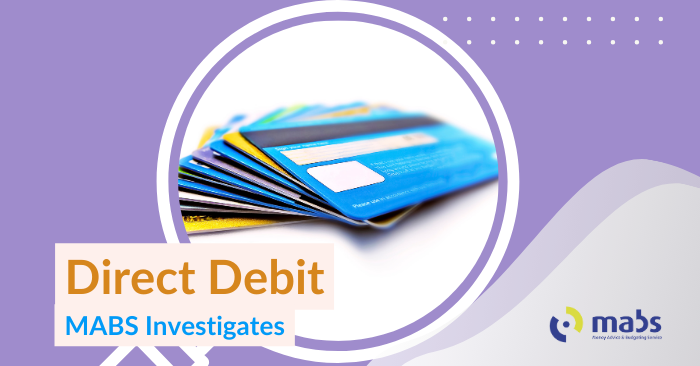Direct Debits – MABS Investigates

In MABS, we receive a lot of great questions about money matters and tackling debt. Questions that we know many people want to ask, but don’t know whom to ask or where to start.
‘MABS Investigates’ is here to help.
In this series, we will answer these questions and “investigate” these topics, to bring clarity and break down the jargon.
The focus of this ‘MABS investigates’ is direct debits. It’s something that most of us use in our daily lives paying utilities, loans and if we can, direct money into our savings. In this blog we’ll cover:
- What is a direct debit?
- How does a direct debit work?
- What happens if I miss a direct debit?
- What’s the difference between a Direct Debit and a Standing Order?
What is a direct debit?
A creditor requests a Direct Debit payment, also known as a DD. Utility providers like your electricity, gas or bins are good examples of this. To debit – charge your account – a fixed or varied amount from your account at a frequency you and the creditor decide when you first authorise the direct debit.
How does a direct debit work?
A direct debit is in the control of the creditor. So, if you want to pay a creditor by direct debit, you must contact that creditor to give them your BIC (Bank Identifier Code) and IBAN (International Bank Account Number), otherwise known as your bank details. Sometimes, you can do this over the phone, or, you may have to complete a form and return it to the creditor. You usually set up a direct debit at the start of a contract, such as when you sign up for an energy company or take out a loan. When you set up a direct debit you are authorising the creditor to take money out of your account at the agreed frequency (every week or every month, for example). This can be a fixed amount each time such as a loan repayment, or a varying amount such as an energy bill.
Example
When Mary took out her loan first, the loan repayment was €108 per month. The interest rate increased after two years, and they increased the loan repayment amount to €110. The bank wrote to Mary to let her know of the change and automatically took the increased amount of €110 the following month. Mary didn’t need to sign any new forms or contact the bank.
Note – Your electricity provider can consider an invoice or bill that you receive as notice of a change in payment amount. So be sure to keep an eye on your bills, especially if they vary. They will usually send you your bill 14 days before they take the direct debit from your account.
If you have a loan with a variable interest rate, meaning that the interest can change, the loan provider will take the new amount. Your loan provider will contact you to confirm any change to the interest rate and the new amount before debiting (taking) it from your account. There may be exceptions to this for example some Credit Unions use a different system.
When you set up the direct debit, you need to keep in mind the day/date you get paid. For example, if you are paid weekly, then try to set the direct debit up weekly. If the creditor insists on a monthly direct debit or a specific payment date, you will need to budget accordingly to ensure you have enough funds in your account before the date of your direct debit.
Example
Mary has a loan from the Credit Union of €5,000, to be repaid over a 5 year term. When Mary got the loan, she was paid monthly so the direct debit was set up monthly on the 27th of the month. She got paid on the 25th but wanted to leave a day in between in case of any issues with her pay being lodged to the account. Her monthly repayments were €101.11. After a year of repaying the loan, she changed jobs and was being paid weekly. She had trouble adjusting her budget from weekly to monthly and ended up missing a couple of payments. She contacted the Credit Union to change the direct debit from monthly to weekly. They agreed and changed her payments to €23.33 per week which became a lot more manageable for Mary.
This may not be available with the banks for a mortgage payment; however, there may be other options to pay the mortgage weekly or fortnightly. You should discuss this with the mortgage provider.
Top Tip – Bank Holidays
Christmas, St Patrick’s Day, Easter and other bank holidays are known as non-banking days. Therefore, any direct debits due to come out on a non-banking day will be taken out of your account the next working day. You need to be aware of direct debits due around the same time as a non-banking day. Make sure you have enough funds in your account to meet your direct debits and standing orders for the next banking day (working day). This applies to standing orders too.
What happens if I miss a direct debit?
Most financial institutions and creditors will charge a fee. This might happen if there is not enough money in your account on the date the direct debit is due. This charge varies from institution to institution so check this out.
Generally, the creditor will try again to debit the money from your account. This could be within the next 5 days. This grace window allows you to ensure there is enough money in your account. This is why it is so important to keep an eye on your account regularly.
The general rule is that if you miss 3 direct debits in a row it will be automatically cancelled. This is to prevent the missed direct debit fee from being repeatedly charged.
You need to check with your creditor, as not all creditors will go looking for the money a second time. Non-payment of a direct debit could lead to a gap in the service you receive or an increase in charges on your account.
What’s the difference between a direct debit and a standing order?
A direct debit is different from a standing order, but they are similar and can often be used interchangeably. A standing order sometimes referred to as s/o, is a payment that you set up yourself on your bank account.
An example would be paying savings into another account. Another good example is rent. Many landlords request that you set up your rent to be paid by standing order to ensure they receive it on the same day each month.
The primary difference between a direct debit and a standing order is who is actioning the payment. The creditor actions a direct debit and a standing order is actioned by you.
Contact Us
Do you have a question for MABS to Investigate? Get in touch and let us know at mabs@ciboard.ie.
If you have a query for one of our advisers or are struggling with your debts, you can call the MABS National Helpline on 0818 07 2000 Monday to Friday, from 9am to 8pm or find the contact details for your local office.
Disclaimer: This blog does not represent legal advice and is intended for guidance only. If you are concerned about your current or future personal financial situation, then please contact an adviser from MABS. Advisers are available by phone, email and in-person in locations nationwide.
Note: We welcome references to and use of the content in this blog. However, please reference MABS, and link said content if you choose to do so.




Facebook
twitter
Instagram